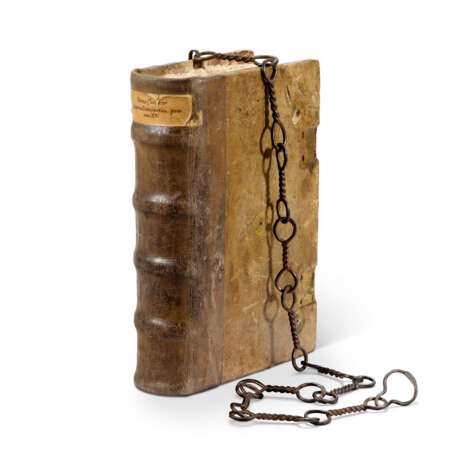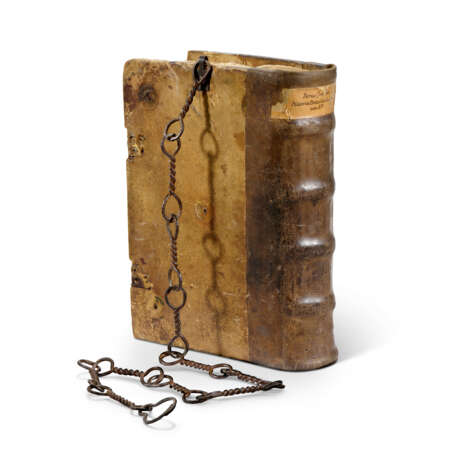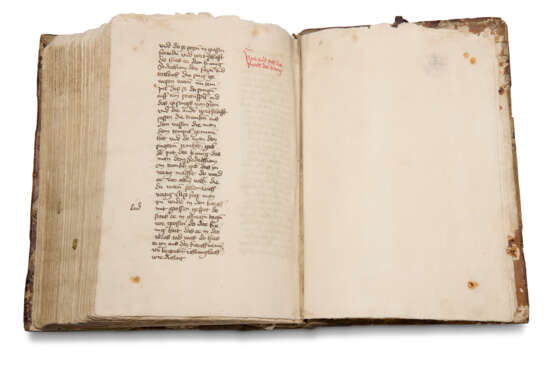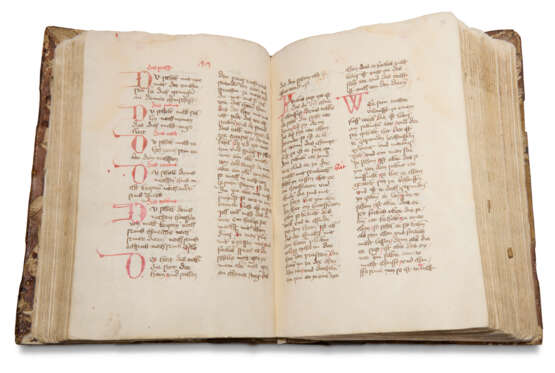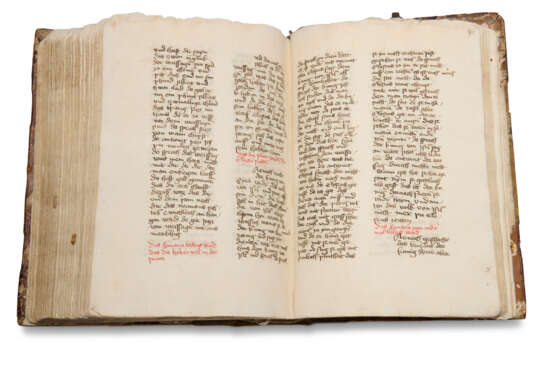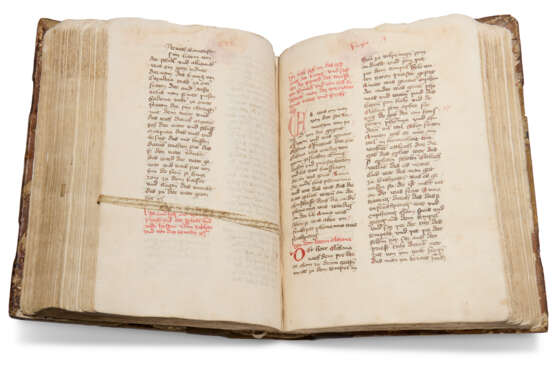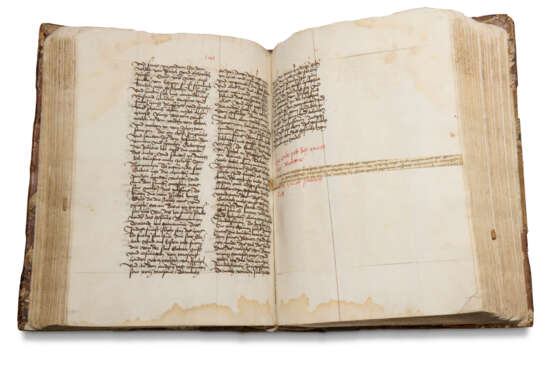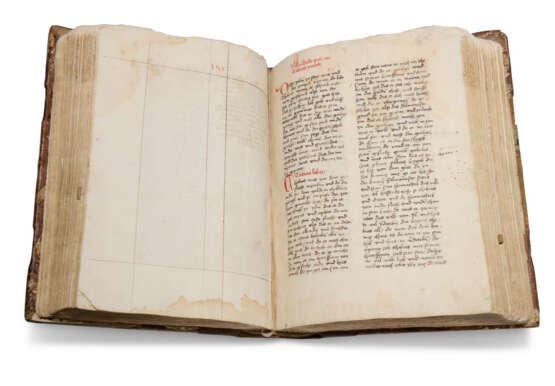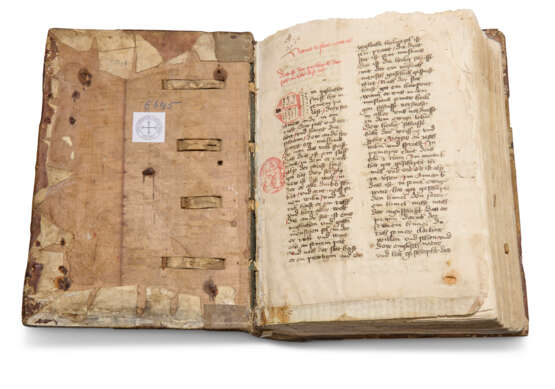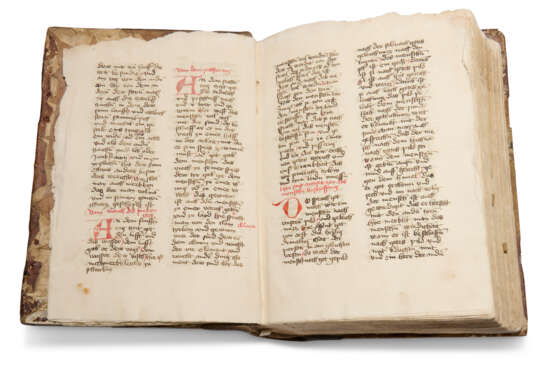ID 1214883
Lot 26 | Peter the Eater's Biblical Abridgment
Valeur estimée
£ 60 000 – 90 000
Petrus Comestor (1100-1178), Historia Scholastica, in Middle High German, decorated manuscript on paper [Austria, Zwettl Abbey, c.1380]
The earliest translation of the Historia Scholastica in Middle High German, in a contemporary chained binding from Zwettl Abbey, once in the collections of the great arctic explorer Johann Nepomuk Wilczek at Schloss Kreuzenstein.
297 x 210mm. 325 leaves, collation: 1-212, 310, 4-1212, 139 (of 14, lacking x-xi, or perhaps never supplied, xii-xiv cancelled blanks), 14-1512, 1614, 17-1812, 197 (of 12, viii-xii cancelled blanks), 20-2712, 289 (of 12, x-xi cancelled blanks, xii lower pastedown), modern foliation in pencil followed here, sporadic early foliation in red, two columns of 29-33 lines written in an Austrian bastarda by three different scribes, written space: 198 x 140mm, catchwords survive, the tabs marking the divisions of the books constructed from long vellum strips cut from 14th-century documents (see Provenance below), headings in red, initials in red throughout, one large initial with brown infill (lacking two text leaves after f.151 with the heading for Ruth — although no other Books open on an entirely new leaf, so perhaps never supplied, opening leaves somewhat frayed and worn at edges, some marginal thumbing and dampstaining).
Binding:
Contemporary, probably Zwettl, binding of plain pale leather over thick, unbevelled wooden boards, sewn on 4 wide bands, evidence of 5 round bosses and 2 wide clasps on each cover, 17/18th-century brown goatskin spine overlay, 19th-century manuscript title label on spine, early chain of 11 twisted links and staple attached at top of rear board (minor repairs, missing front pastedown).
Provenance:
(1) Cistercian Abbey at Zwettl, Waldviertel, Austria. The following lot is in a similar chained binding and has exactly the same provenance. The vellum strips inserted into the manuscript that serve as tabs marking the divisions of the books are from a 14th-century, probably notarial, document. The strips were analysed by Wilczek's librarian (see below): legible are the names of Sigmund der Slewnczer and his wife Dorothea, noting a gift to a church in Steinkirch. Other legible names are Benk Swertperger and Anna, his sister; Lorenczs des Swertperger's children and Otto von Meyssaw (d.1359).
(2) Johann Ernst von Jamaigne (1648-1719). When this manuscript was described by Hans Vollmer (Vollmer, 1912, pp.142-3) it contained von Jamaigne's printed armorial bookplate on the inside upper cover, 'Jo: Ern: de Jamagne Protonot: Apost: SS: Th: D: Cons: Pass: Dec: et Paroch: Urb: Waidhov: ad Thejam'. Von Jamaigne was an Austrian theologian and Protonotary Apostolic in Waidhofen an der Thaya in the diocese of St. Pölten.
(3) Piarists of Vienna: an ?18th-century red ink bookstamp on f.1 with the Piarist emblem of sun, crown with a cross and the Greek letters mu, rho, theta, and upsilon (an anagram for 'Mary, Mother of God'). A manuscript of Nicolaus de Gretz in a 15th-century Austrian binding sold at Christie's, 16 October 2020, lot 84, has the same von Jamaigne-Piarist provenance, and a title label on the spine written in the same hand as the present manuscript.
(4) Johann Nepomuk Wilczek (1837-1922), Austrian arctic explorer, main sponsor of the Austro-Hungarian North Pole Expedition of 1872-74 and celebrated patron of the arts. The present manuscript was no 5645 (in blue ink on inside upper board) in his library at Schloss Kreuzenstein, a monumental mansion to the north of Vienna redesigned in the late 19th century by Carl Gangolf Kayser, and now home to a museum that houses Wilczek's extensive art collections.
(5) Gilhofer & Ranschburg, Vienna, their description c.1989.
(6) Zisska & Kistner, Munich, Auktion 15, 7-10 May 1990, lot 125.
(7) Heribert Tenschert, cat. 22 (1990), no 18.
(8) The Schøyen Collection, MS 690.
Content:
Genesis - Ruth (heading) ff.1-151 (lacking Ruth or perhaps never supplied); Tobit - 2 Maccabbees ff.152-220v; 1-4 Kings ff.221-325.
Peter Comestor (literally 'Peter the Eater', from his voracious appetite for knowledge) wrote influential sermons and a gloss on the Gospels, but it was the Historia Scholastica that brought him lasting renown. Providing a continuous history from the Creation until the end of the Acts of the Apostles, it was based upon the narrative books of the Bible, where necessary correlating different accounts of an event and marrying disjointed sequences. Gaps in the narrative were filled by drawing upon both patristic and classical authors. Translated into every major western European vernacular, it became a widespread resource for biblical material until the Reformation and continued to serve as an essential school text well into the 16th century. 'Because of its comprehensive assembly of apocryphal and legendary elements, and because of its frequent translation and paraphrase, the Historia was the single most important medium through which a popular Bible took shape, from the thirteenth into the fifteenth century, in France, England, and elsewhere' (J.H. Morey, 'Peter Comestor, Biblical Paraphrase, and the Medieval Popular Bible', Speculum, 68, no 1 (1993), p.6). As the formal model for numerous translations and adaptations in Latin and vernacular languages, it formed a link between Latin scholastic textual practices and vernacular narrative.
Of the 116 manuscripts of biblical abridgments, or 'Historienbibeln', in German listed by the Handschriftencensus: Eine Bestandsaufnahme der handschriftlichen Überlieferung deutschsprachiger Texte des Mittelalters, twelve, including the present copy, are drawn from Peter Comestor's Historia and belong to Group IIIa as defined by Vollmer (Vollmer, 1912, p.14), the majority of which are in German or Austrian institutions. Vollmer himself knew of only 6 witnesses of this type. The present Middle High German translation not only antedates the earliest printed editions of Augsburg, Strassbourg and Utrecht, all of 1473, but is the earliest of these witnesses.
Literature
Bloh, U. von, Die illustrierten Historienbibeln. Text und Bild in Prolog und Schöpfungsgeschichte der deutschsprachigen Historienbibeln des Spätmittelalters, 1993, p.73, note 173.
Kornrumpf, G., 'Die österreichischen Historienbibeln IIIa und IIIb', Deutsche Bibelübersetzungen des Mittelalters. Beiträge eines Kolloquiums im Deutschen Bibel-Archiv, unter Mitarbeit von Nikolaus Henkel hg. von Heimo Reinitzer, 1991, p.355 (no 55).
Lackner, F., 'Handschriften aus der Burg Kreuzenstein in der Österreichischen Nationalbibliothek', Codices Manuscripti 27/28 (1999), p,10, note 10.
Vollmer, H., Ober- und mitteldeutsche Historienbibeln, 1912, pp.142-3 (no 55).
Vollmer, H., Eine deutsche Schulbibel des 15. Jahrhunderts. Historia scholastica des Petrus Comestor in deutschem Auszug mit lateinischem Paralleltext, I, 1925, plate IV (after p.352).
Exhibited
Conference of European National Librarians, Oslo, September 1994.
'European medieval manuscripts from The Schøyen Collection'. University of Oslo. Domus Bibliotheca, 6-15 May 1996.
| Lieu d'origine: | Autriche, Europe de l'Ouest, Europe |
|---|---|
| Catégorie maison de vente aux enchères: | Manuscrits médiévaux et de la Renaissance, Livres et manuscrits |
| Lieu d'origine: | Autriche, Europe de l'Ouest, Europe |
|---|---|
| Catégorie maison de vente aux enchères: | Manuscrits médiévaux et de la Renaissance, Livres et manuscrits |
| Adresse de l'enchère |
CHRISTIE'S 8 King Street, St. James's SW1Y 6QT London Royaume-Uni | |
|---|---|---|
| Aperçu |
| |
| Téléphone | +44 (0)20 7839 9060 | |
| Commission | see on Website | |
| Conditions d'utilisation | Conditions d'utilisation |
